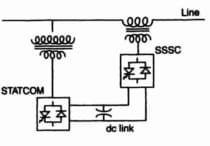 |
| HVDC/HVE |
1. The break-even distance is the distance beyond which__________.
a. DC transmission is
economical
b. AC transmission is economical
c.cost of both systems are the same
d.both (b) & (c)
2. In a bipolar system_______.
a. both conductors are positive
b.both conductors are negative
c.one
conductor is positive & the other negative
d.one conductor is positive or negative &
other is at ground potential
3. In a monopolar system, usually
the pole is_____.
a. positive
b.negative
c. positive & negative
d. alternately positive & negative
4. Modern HVDC systems are
all_____.
a. 3-pulse converters
b. 6-pulse converters
c.
12-pulse converters
d. 24-pulse converters
5. Short circuit ratio of an HVDC
grid is_________.
a. DC power flow/kVA
b. ACMVA/DCMW
c. voltage/current at the short circuit point
d.
short circuit MVA at converter bus rated DC power MW
6. The first HVDC scheme in INDIA
is__________.
a. Vidhyachal back-to-back system
b. Chandrapur-Padghe scheme
c. Delhi-Rihand 500kV system
d.
Sileru-Barsoor system
7. HVDC-VSC scheme
employs_______.
a.
IGBT valves
b. light or optically triggered thyristor
valves
c. mercury arc valves
d. mosfETs & GTO valves
8. The main advantage of HVDC-VSC
scheme is_______.
a.
both active & reactive powers can be controlled
b. does not require DC filters
c. can be used for very high power, more than
1500MW
d.all the above
9. A thyristor valve conducts
when_______.
a. anode is positive
b. anode is negative
c.
anode is positive with positive gate pulse
d.anode is positive with negative gate pulse
10. A thyristor valve is
fabricating using_______.
a. SCRs connected in series (all)
b. SCRs connected in parallel (all)
c.
SCRs connected in series & parallel as modules
d. all the above
11. A 12-pulse converter are
used in modern converters because of_______.
a. reduced current
b. reduced ripple
c. increased voltage & reduced harmonics
d.both
(b) & (c)
12. A 12-pulse connection,
transformers are connected_______.
a. Delta/Delta (both)
b. Star/star (both)
c. star/Delta (both)
d. one
star/star & other star/Delta
13. IGBT converters operate on
the principle of_______.
a.
voltage source converter
b. current source converter
c. power source converter
d. either (a) or (b)
14. IGBT requires_________.
a. large current for triggering
b.large
voltage pulse for triggering
c. sine wave voltage for triggering
d. anyone (a), (b) or (c)
15. Compared to SCRs, IGBT
have_______.
a. more turn-on, turn-off time
b.
less turn-on, turn-off time
c. both have some characteristics
d. turn-on, turn-off times can be more or
less depending on the circuit
16. A pack in an IGBT valve
comprises______.
a. triggering gate pulse circuit
b. parallel connect IGBTs
c.
series & parallel connected IGNT's with projection
d.none of the above
15. Coolant used in thyristor/IGBT valves
is_______.
a. Air
b.SF
c. Freon
d. Oxygen
16. A 12-pulse converter consists
of_______.
a. two
6-pulse converters in series
b. two 6-pulse converters in parallel
c. (a) or (b)
d. (a) & (b)
17. Power transfer through AC
systems depends on_________.
a. sending & receiving end voltages
b. phase angle difference between sending end
& receiving end voltages
c. reactance of the line
d. all the above
18. Power transfer through DC
line depends on_______.
a.
sending & receiving end voltages
b.number of pulses in the rectifier
c. line resistance
d.none of the above
19. Advantage of DC link for
power transfer is_________.
a.
easy controllability of power
b. more economical
c. it is an asynchronous tie
d. less insulation requirement
20. Control of DC power in a DC
link is done by_______.
a. control
b. Y control
c. transformer tap changing
d. all the above





0 Comments
If you have any doubt, feel free to ask.